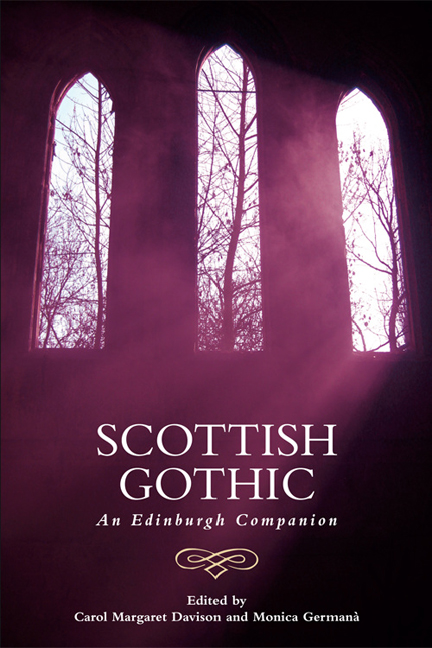Book contents
- Frontmatter
- Contents
- Acknowledgements
- 1 Borderlands of Identity and the Aesthetics of Disjuncture: An Introduction to Scottish Gothic
- 2 ‘The Celtic Century’ and the Genesis of Scottish Gothic
- 3 The Politics and Poetics of the ‘Scottish Gothic’ from Ossian to Otranto and Beyond
- 4 Robert Burns and the Scottish Bawdy Politic
- 5 Scottish Gothic Drama
- 6 Scottish Gothic Poetry
- 7 Calvinist and Covenanter Gothic
- 8 Gothic Scott
- 9 Gothic Hogg
- 10 ‘The Singular Wrought Out into the Strange and Mystical’: Blackwood's Edinburgh Magazine and the Transformation of Terror
- 11 Gothic Stevenson
- 12 J. M. Barrie's Gothic: Ghosts, Fairy Tales and Lost Children
- 13 The ‘nouveau frisson’: Muriel Spark's Gothic Fiction
- 14 Scottish Gothic and the Moving Image: A Tale of Two Traditions
- 15 New Frankensteins; or, the Body Politic
- 16 Queer Scottish Gothic
- 17 Authorship, ‘Ghost-filled’ Islands and the Haunting Feminine: Contemporary Scottish Female Gothic
- Notes on Contributors
- Index
13 - The ‘nouveau frisson’: Muriel Spark's Gothic Fiction
Published online by Cambridge University Press: 20 December 2017
- Frontmatter
- Contents
- Acknowledgements
- 1 Borderlands of Identity and the Aesthetics of Disjuncture: An Introduction to Scottish Gothic
- 2 ‘The Celtic Century’ and the Genesis of Scottish Gothic
- 3 The Politics and Poetics of the ‘Scottish Gothic’ from Ossian to Otranto and Beyond
- 4 Robert Burns and the Scottish Bawdy Politic
- 5 Scottish Gothic Drama
- 6 Scottish Gothic Poetry
- 7 Calvinist and Covenanter Gothic
- 8 Gothic Scott
- 9 Gothic Hogg
- 10 ‘The Singular Wrought Out into the Strange and Mystical’: Blackwood's Edinburgh Magazine and the Transformation of Terror
- 11 Gothic Stevenson
- 12 J. M. Barrie's Gothic: Ghosts, Fairy Tales and Lost Children
- 13 The ‘nouveau frisson’: Muriel Spark's Gothic Fiction
- 14 Scottish Gothic and the Moving Image: A Tale of Two Traditions
- 15 New Frankensteins; or, the Body Politic
- 16 Queer Scottish Gothic
- 17 Authorship, ‘Ghost-filled’ Islands and the Haunting Feminine: Contemporary Scottish Female Gothic
- Notes on Contributors
- Index
Summary
If Muriel Spark has strong elements of Gothic apparatus in her work, then this is generally of the kind that works through urban rather than ‘wilder’ or more ‘sublime’ settings. Gothic, supernatural, uncanny elements are used in Spark's fiction, most especially, to undermine and satirise the modern, material, town-based life of twentieth-century humanity and to signal an alternative immaterial, moral, spiritual reality in which, as a Christian, she believes. Alongside her crucial Catholicism, Spark's Scottishness provides a particular Gothic accent to her work through a set of texts on which she frequently riffs. These include the Scottish Border Ballads, James Hogg's The Private Memoirs and Confessions of a Justified Sinner (1824) and Robert Louis Stevenson's Strange Case of Dr Jekyll and Mr Hyde (1886). This set of texts does not make for any ‘essential’ Scottish Gothic canon, but rather relies on Hogg's steepage in the Ballads, Stevenson's knowledge of Hogg and Spark's interest in all of these things. These texts have tended to be given less emphasis in Spark criticism than her more explicit, critical engagement with English Gothic such as Mary Shelley or the Brontës, or even John Henry Newman whose religious writings belong, to some extent, within the context of the space mapped out by nineteenth-century Gothicism.
In her short stories, Spark develops a miniaturist sensationalism where human life is treated in shocking, seemingly gratuitous, ways. These also regularly feature an explicitly supernatural layer. ‘The Portobello Road’ (1958) is narrated by a ghost who acquires the nickname of ‘Needle’ after she finds one in a haystack. Our narrator has been murdered, her body being discovered in a haystack, and this concatenation between the two found needles mimics, in a way, the incremental repetition of the Ballads where lines/events are reiterated for intensity of effect. The violent death and the lingering revenant are also ‘stock’ ballad elements. The story ends in a way that hallmarks Spark's outlook on the world throughout her oeuvre, as Needle contemplates herself and some friends in a photograph, ‘each reflecting fearlessly in the face of George's camera the glory of the world, as if it would never pass’ (Spark 2011: 524).
- Type
- Chapter
- Information
- Scottish GothicAn Edinburgh Companion, pp. 168 - 180Publisher: Edinburgh University PressPrint publication year: 2017

